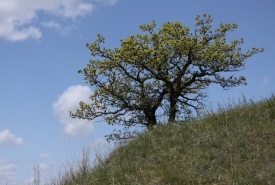Yellow Quill Prairie

Bur oak with mixed-grass prairie on the Yellow Quill Prairie, MB (Photo by NCC)
The Nature Conservancy of Canada (NCC) established the Yellow Quill Prairie Preserve, south of Brandon, Manitoba, in 1998. The property is giving the few remaining species at risk in this area a better chance for survival by maintaining the last intact remnants of their natural habitats.
NCC's Yellow Quill Prairie Preserve is located 20 kilometres southeast of Brandon and two kilometres north of the junction of the Souris and Assiniboine rivers. It abuts the western boundary of the Canadian Forces Base Shilo training grounds and is immediately north of 324 hectares (800 acres) of the Assiniboine Corridor Wildlife Management Area.
An ecosystem under threat
A recent increase in cultivation and irrigation of native range in southwestern Manitoba has put new pressure on the few remnants of mixed grass prairie grasslands. At one time, these grasslands covered thousands of square kilometres. Today, less than 10 per cent remains intact.
Conservation values
The prevalence of dry, sandy soils has historically limited the agricultural capability of these lands. A rare piece of intact native mixed grass prairie, it is a rolling sandy prairie of mixed grasses interspersed with aspen forests. Rare plants like red three-awned grass and sand bluestem are also found here.
Wilderness enthusiasts enjoy spotting the species that roam here, including red-tailed hawk, moose, elk, deer and fox. The Yellow Quill Prairie is a preferred site for bird watchers wishing to see mountain bluebird and Sprague's pipit in their natural habitat. The latter is listed as a threatened species, as is mule deer.
Endangered species such as northern prairie skink, discovered in the preserve just two years ago, also fight for survival here.
Partners in conservation
The Yellow Quill Prairie Preserve was established in partnership with Mountain Equipment Co-op, Wawanesa Insurance Company, The Thomas Sill Foundation, Manitoba Naturalists Society, TD Canada Trust Friends of the Environment Foundation and several exceptionally generous individuals.
The Crown Lands Department of the Manitoba Government added 324 hectares (800 acres) of adjacent prairie land to complete the project.




